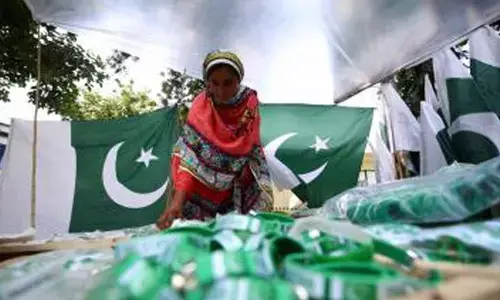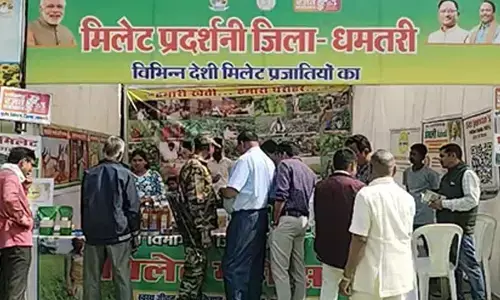Restoring past glory of Telangana agriculture

Convert agriculture infrastructure fund into grant: Telangana to Centre
When Chief Minister K Chandrashekar Rao reiterates time and again the essentiality of regulatory farming in the State, it connects people like me, who lived with agriculture decades ago
When Chief Minister K Chandrashekar Rao reiterates time and again the essentiality of regulatory farming in the State, it connects people like me, who lived with agriculture decades ago. In whichever position such people may be living now, the olden days, the past memories will inflate afresh.
The wonderful village atmosphere pervading and prevailing then, with agriculture playing a pivotal and predominant role was simply great.
The implements associated with farming, skilled people with expertise to take up works related to agriculture in time and those villagers despite being illiterate but having knowledge and wisdom to predict the suitability of crop for a particular soil and season for more profitability were all god sent gifts then.
In India and more so in Telangana State, agriculture dates back to thousands of years. The agriculture sector had undergone sea change in the last century responding to everchanging technological advancements as well as the expansion of the global market.
In the place of human and natural resources and organic manures, there came machines, chemical fertilisers and pesticides. Notwithstanding the fact that yield of the crops increased multi-fold due to technology, the climatic equilibrium took a beating and health hazards became order of the day. The returns on the increased yield became a necessity to invest on fertilizers in the subsequent years.
While recollecting the rural atmosphere of half-a-century ago, several sweet memories will haunt the yesteryear's farmer. The rich and green paddy fields, flower gardens decked up with jasmine, mango groves, maize orchards, red chilli fields, the spacious open well, jowar fields, the cucumber creepers, the plough, the temporary uppish platform (Manche), oxen, cows, goats, heaps of dry grass, well at the house, lemon and banana trees adjoining the well, the churning of butter and buttermilk at the backyard of the house, eating fresh butter, eating overnight cooked rice with yoghurt mixed mango pickle in the morning, placing the cots outside the house in the evening after cleaning the ground with water, sleeping on the cot and looking at the vast sky up, and a host of these pictures emerge and give an enjoyable feelings to one.
The agriculture operations normally take off in the beginning of summer season. They start with transporting cattle manure to the farmlands. Initially the farm owner will transport manure of the family cattle to the farm. A separate place used to be earmarked to stock the manure.
In addition to this, manure used to be bought from those who had no land of their own. All the payments were used to be in the form of grain, some sort of barter system with no cash transactions.
A lot of cattle particularly the sheep were also kept on the field day and night for the manure collection. Even this is at a price. The manure thus collected used to be the organic fertiliser for the farm. Added to this, the silt taken out from the tanks was also transported to the farmlands.
The transportation of manure used to start early in the morning by getting the cart loads ready. After transporting the manure to the farmlands till midday, people used to come back to homes and continue in the evenings till late in the nights.
During the full moon days, the activity used to take place at nights also. This would continue till the first rain of the monsoon. Even after the onset of monsoon, whenever there was discontinuation of rains, this activity used to go on.
After the onset of monsoon, there would be some change in the agriculture activity. Seedling to raise paddy nurseries, tilling of the soil with ploughs and the works on the field used to be in tune with the nature of rains.
Groundnut and red grams used to be the intercrops. Paddy used to be cultivated when there was adequate water in the tanks. Later they used to go for Jowar.
Before transplanting the paddy saplings, the entire land used to be tilled with ploughs. In general, women used to transplant the paddy saplings. They used to do the work with tremendous enthusiasm by singing songs and cracking jokes among them.
After the transplantation, water used to be supplied in phases. Sometimes farmers used to go at nights to water their fields by turns. After paddy plants reached a specific height, weed was removed. After three or four months, when the crop was ripe, harvesting used to be done.
At a convenient time, crops used to be harvested, collected and brought home. People used to sleep overnight in the field for the entire process of work. Labour wages were paid in the form of paddy.
The groundnut farming was a little bit different. It used to start with preparing the seed. Farmers used to call labour home and ask them to take out the seeds from the groundnut harvested last year.
Some of these works used to be outsourced to the labour who used to work from home. Every day by evening the labour based on their expertise would take out a pot or two filled with the seeds.
Paddy used to be given as their wage. While picking up the seeds some of the groundnuts used to break into pieces, which were used to make edible oil. Groundnut used to be the major crop.
The harvesting was done by pulling out the plants and separating the groundnut from the roots. Seedling groundnut seeds in combination with red gram, through the plough into the land was a high-skilled job and only a few people were able to do it.
Groundnut crop would come for harvesting first and the red gram would come two months later. Once the ground plants reached a height, they were skilfully tamed by the plough, which is also an art by itself.
Only a few farmers had the required measurements to measure the crop. The entire produce used to be measured with great precision. The produce used to be stored in special enclosures in the house.
Paddy used to be sold at a proper time in the markets. Separate sacks of paddy used to be kept aside to use as seeds the next year. Very fascinating fact is that paddy heaps which were of lakhs of rupees of value used to be kept open in the fields by farmers without worrying about any theft.
Some farmers used to go for red chilli and some for the tobacco cultivation. Some for maize, some for edible roots. Some even used to grow cauliflower, cabbage etc. Mango groves were also part of the farm sector.
In the fields, cucumber creepers used to be present. People used to eat raw cucumbers. Green gram used to be eaten after roasting them on fire. Estates used to have an open well. Drawing water from these open wells using oxen was also a skilled one. It was also a fun.
A portion of the yield used to be kept aside to use them as seeds. There was no habit of buying the seeds then. There was very less use of chemical fertilisers or pesticides.
When the use of chemical fertilisers and pesticides started, keeping aside a portion of the yield for seeds was also given a go by. Desirous of high yielding varieties, buying of seeds in the open market had begun. Now there is no option.
As Chief Minister K Chandrashekar Rao had been saying, the good olden days for farming should come back. The overuse of fertilisers and pesticides should be stopped. The seeds required for each village should be produced in the village itself.
As desired by the CM, based on the advice given by the Agriculture Extension Officers, farmers should cultivate crops. If agriculture is to become profitable, there is no other choice but to go in for regulatory farming.
(The writer is Chief PRO to the Chief Minister of Telangana.views expressed are personal)
















